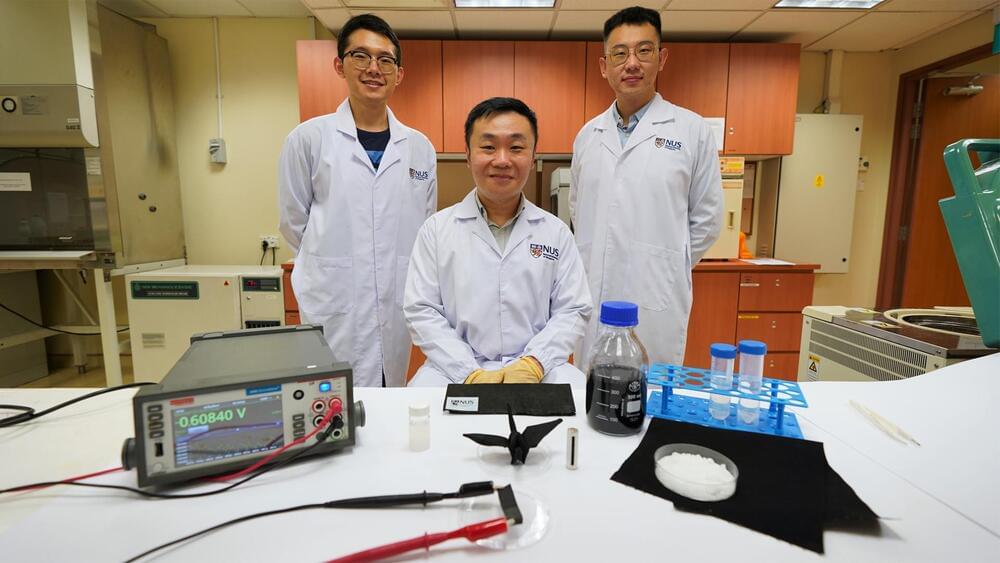The machine learning technique that taught notorious text generator GPT-3 to write can also help robots make sense of spoken commands.





This new invention is highly scalable since its raw materials are commercially available and easy to access.
A team of researchers from the National University of Singapore’s (NUS) College of Design and Engineering (CDE) has developed a self-charging electricity generation (MEG) device that generates electricity from air moisture, according to a press release by the institution.
Imagine being able to generate electricity by harnessing moisture in the air around you with just everyday items like sea salt and a piece of fabric, or even powering everyday electronics with a non-toxic battery that is as thin as paper. A team of researchers from the National University of Singapore’s (NUS) College of Design and Engineering (CDE) has developed a new moisture-driven electricity generation (MEG) device made of a thin layer of fabric — about 0.3 millimetres (mm) in thickness — sea salt, carbon ink, and a special water-absorbing gel.
The concept of MEG devices is built upon the ability of different materials to generate electricity from the interaction with moisture in the air. This area has been receiving growing interest due to its potential for a wide range of real-world applications, including self-powered devices such as wearable electronics like health monitors, electronic skin sensors, and information storage devices.
Key challenges of current MEG technologies include water saturation of the device when exposed to ambient humidity and unsatisfactory electrical performance. Thus, the electricity generated by conventional MEG devices is insufficient to power electrical devices and is also not sustainable.
His new prototype had 39 percent greater torque over a traditional motor.
A young engineer called Robert Sansone won the first prize, and winnings of $75,000, at this year’s Regeneron International Science and Engineering Fair (ISEF), the world’s largest international high school STEM competition.
As per Smithsonian Magazine, his new invention could one day transform the electric vehicle (EV) industry. It is a synchronous reluctance motor with improved performance over previous models.
Robert Sansone is a natural born engineer. From animatronic hands to high-speed running boots and a go-kart that can reach speeds of more than 70 miles per hour, the Fort Pierce, Florida-based inventor estimates he’s completed at least 60 engineering projects in his spare time. And he’s only 17 years old.
A couple years ago, Sansone came across a video about the advantages and disadvantages of electric cars. The video explained that most electric car motors require magnets made from rare-earth elements, which can be costly, both financially and environmentally, to extract. The rare-earth materials needed can cost hundreds of dollars per kilogram. In comparison, copper is worth $7.83 per kilogram.

The launch of Artemis I is within touching distance.
NASA’s Space Launch System (SLS) is almost ready for launch. The U.S. space agency’s big new rocket reached Launch Complex 39B at NASA’s Kennedy Space Center in Florida at approximately 07:30 am EDT after a 10-hour journey from the Vehicle Assembly Building (VAB).
NASA recently announced an August 29 launch date for its Artemis I mission, which will see SLS launch the agency’s Orion capsule on a trip to the moon and back. This came after the space agency successfully completed a much-delayed wet dress rehearsal in June, during which it filled SLS with fuel and performed a simulated countdown that stopped just short of launch.
Around 7:30 a.m. EDT the Space Launch System rocket and Orion spacecraft for the Artemis I mission arrived atop Launch Complex 39B at NASA’s Kennedy Space Center in Florida after a nearly 10-hour journey from the Vehicle Assembly Building.
In the coming days, engineers and technicians will configure systems at the pad for launch, which is currently targeted for no earlier than Aug. 29 at 8:33 a.m. (two hour launch window). Teams have worked to refine operations and procedures and have incorporated lessons learned from the wet dress rehearsal test campaign and have updated the launch timeline accordingly.

Saccorhytus is not our grandpa anymore.
Scientists from Bristol University have solved a mystery of a 500 million-year-old microscopic creature with a mouth but no anus. The study reveals that the spiny creature is not the earliest human ancestor, after all.
This creature — called Saccorhytus — was first discovered in 2017. The study found that a wrinkly sack with a vast mouth entwined by spines and holes is a primitive feature of the deuterostome group from which our ancestors emerged.
Saccorhytus coronarius are millimetric fossils from the early Cambrian period in China that are proposed to represent the most basal known deuterostomes.
And these miniaturized brains could save regular-sized brains.
Electroencephalography (EEG) caps are medical devices doctors use to diagnose brain disorders like epilepsy and seizures in patients. In the past decade, scientists have created 3D mini-brains called brain organoids from human-derived stem cells that mimic some aspects of brain development. A team of researchers at John Hopkins University has recently developed the world’s smallest EEG caps to study these more efficiently. The micro EEG caps can be used on a brain organoid the size of a pen dot.
Brain organoids can mimic some key features of the human brain. Scientists create them to understand the human brain’s development process and the factors leading to various neural disorders. Moreover, such mini-brains can also be used to perform experiments that researchers would have to otherwise perform on a real brain. Thus, eliminating the need to conduct tests on live human and animal subjects. has long been the stuff of science fiction but now mind-reading machines may actually be here and they may not be invasive. Researchers from the Russian corporation Neurobotics and the Moscow Institute of Physics and Technology have found a way to visualize a person’s brain activity as actual images without the use of invasive brain implants.

Does that then prove he is a robot?
Close to a year after social media giant Facebook rebranded itself as Meta — to reflect its new strategy and vision to build the new version of the internet — its primary product, the famous metaverse, looks mediocre at best. But that is something CEO Mark Zuckerberg is failing to see, a Forbes.
Last October, when Facebook’s intent for a major rebranding was revealed, many questioned its timing. The company was going through a tough phase as whistleblowers revealed incriminating details of the company’s practices and regulators pushed for breaking up the company that also owns WhatsApp and Instagram.
Yesterday, Mark Zuckerberg once again made the rounds being roasted on Twitter, not due to barbeque sauce or surfing, but because of yet another screenshot he posted from Horizon Worlds, this one a Facebook post celebrating the game coming to France and Spain.
How intelligent can robots get?
Robots are getting smarter, which means they are better able to execute our commands. A number of different companies worldwide focus their attention on creating robots but one company in particular is really taking the lead on this lofty goal: Google.
A new language modelAccording to Fast Company, Google is achieving this feat through its latest milestone in robot software research — a new language model called PaLM-SayCan (Pathways Language Model).
Remember, in 2017, when Elon Musk said that in a few years, robots would move so fast that you will need a strobe light to see them? Good. So do we. The modern age of robotics embodies some of the highest levels of engineering and human ingenuity. However, when people talk about these machines, they can be very opinionated. There sometimes seems to be no middle ground when people discuss robotics. Some people either think robots are amazing, or are worried they will take your job, or fear they will eventually over the world.
Robots will continue to become more advanced. Over the past few years, we have seen established companies and start-up-made debut machines that can move like us, and even talk like us.